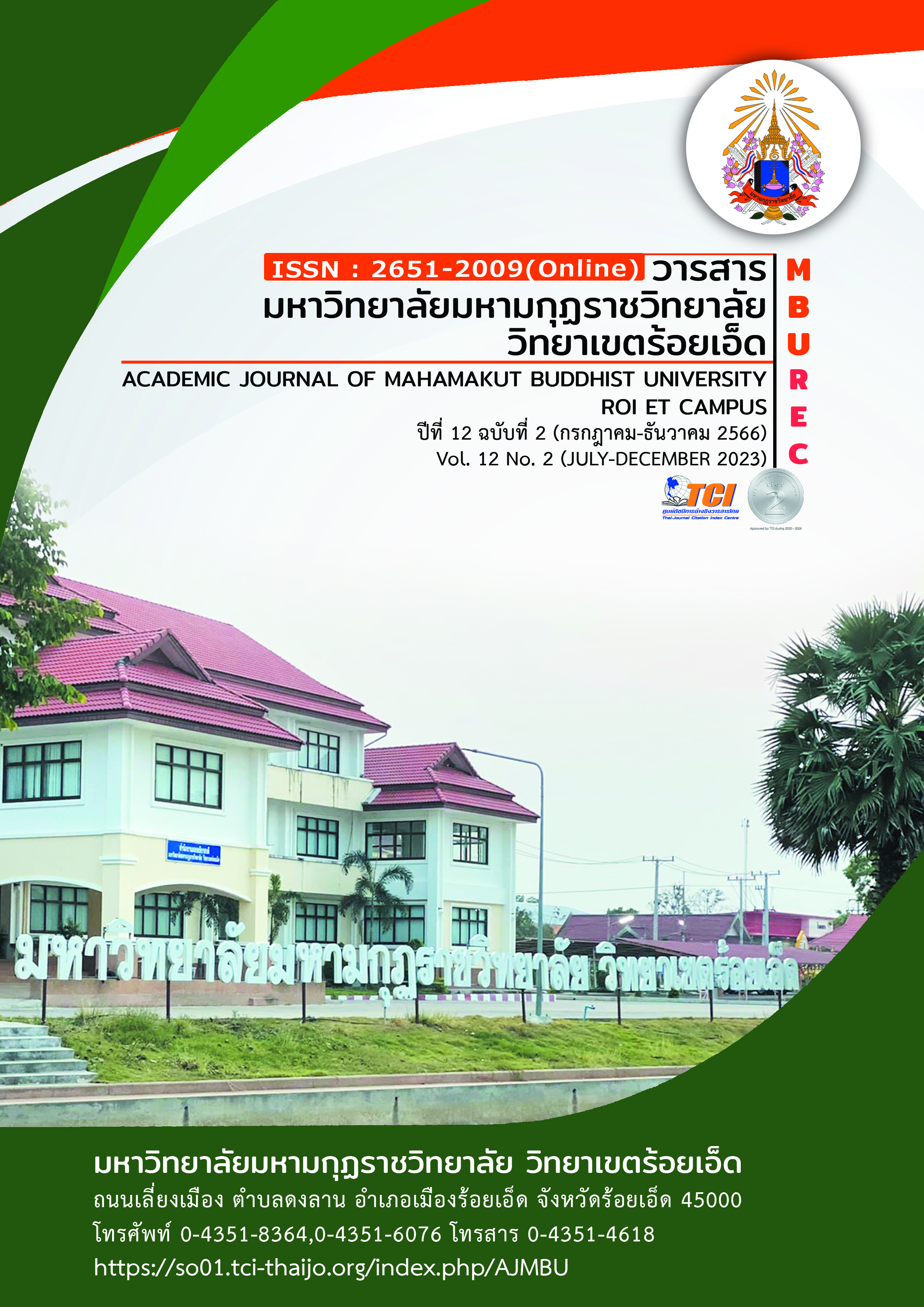INNOVATION IN FACILITY AND INFRASTRUCTURE MANAGEMENT (SI) TO UPGRADE CHAIYAPHUM RAJABHAT UNIVERSITY TO GREEN UNIVERSITY
Main Article Content
Abstract
The objectives of this research are to 1) develop the body of knowledge Technology and innovation in locations and infrastructure appropriate to the Chaiyaphum Rajabhat University context. To become a green university 2) Develop a management model for locations and infrastructure of Chaiyaphum Rajabhat University to become a green university and 3) Transfer technology and innovations for management of locations and infrastructure of green university The sample group used in the research included students in the service area, students, personnel of Chaiyaphum Rajabhat University and representatives of villagers around Chaiyaphum Rajabhat University, totaling 225 people. Tools used in the research included questionnaires and interviews. Statistics used in data analysis include basic statistics, data analysis. From the questionnaire, including the mean and standard deviation, and qualitative data were analyzed from content analysis.
The research results were found: 1) Results of the study of student representatives' satisfaction with the development of Chaiyaphum Rajabhat University. Towards becoming a green university overall is at a high level. When considering each aspect, it was found that the aspect of landscape improvement was the most satisfying. Followed by curriculum and research and supporting activities towards becoming a green university, respectively. The building and facility aspect was the least satisfied. 2) Results of the development of the facility and infrastructure management model. of Chaiyaphum Rajabhat University To become a green university, consisting of 1) learning resources and study and study innovative energy technology Community and conservation careers Restoring natural resources. 2) Activity area for students and staff to participate in activities. 3) Improving the stadium by maintaining the original stadium to be ready for use and in the process of constructing a standard swimming pool as a recreation area for students and staff, and 4) determining green zones and planting forests Added to be an area for conservation and restoration of natural resources. 3) Results of technology transfer and innovation in management of locations and infrastructure of the Green University. Provide training and transfer knowledge and innovation to target groups. Including students and people around the university have 8 learning bases consisting of 1) Biochar or Biochar burning base 2) Biogas or Biomethane production base 3) Distribution base. Water with solar cells or solar panels (Solar Cell) 4) Non-recycled organic fertilizer production base 5) Bio-fermented water production base 6) Azolla culture base 7) Closed underground water bank base and 8) Base smart greenhouse.
Article Details

This work is licensed under a Creative Commons Attribution-NonCommercial-NoDerivatives 4.0 International License.
References
กองนโยบายและแผน. (2563). ยุทธศาสตร์การพัฒนามหาวิทยาลัยราชภัฏชัยภูมิ. ชัยภูมิ : มหาวิทยาลัยราชภัฏชัยภูมิ.
เทคโนโลยีชาวบ้าน. (2566). เครื่องสูบน้ำพลังงานแสงอาทิตย์นวัตกรรมเด่น มหาวิทยาลัยราชภัฏสกลนคร. สืบค้นเมื่อ 7 มิถุนายน 2566. จาก https://www.technologychaoban.com/ thai-local-wisdom/article_149481
ธรัช อารีราษฎร์. (2557). มหาวิทยาลัยสีเขียว : การดำเนินงานกรีนไอที. วารสารวิชาการการจัดการเทคโนโลยีสารสนเทศและนวัตกรรม. 1(2). 64-77.
ธวัชชัย บัวขาว และมนสิชา เพชรานนท์. (2553). การกำหนดนโยบายและแนวทางปฏิบัติสู่มหาวิทยาลัยสีเขียว : กรณีศึกษา มหาวิทยาลัยทักษิณ วิทยาเขตพัทลุง. วารสารวิชาการ คณะสถาปัตยกรรมศาสตร์ สจล. 14(1). 40-55.
ประมุข ศรีชัยวงษ์. (2565). การประยุกต์ใช้หลักปรัชญาของเศรษฐกิจพอเพียงสู่ความยั่งยืน. ขอนแก่น : หจก. โรงพิมพ์คลังนานาวิทยา.
ปิยะมาศ สามสุวรรณ และสมทิพย์ ด่านธีรวนิชย์. (2552). การมีส่วนร่วมของนักศึกษาต่อการจัดการสิ่งแวดล้อมที่เกี่ยวข้องกับกิจกรรมการเรียนการสอนในมหาวิทยาลัยสงขลานครินทร์ วิทยาเขตสุราษฎร์ธานี. การประชุมเสนอผลงานวิจัยระดับบัณฑิตศึกษา มหาวิทยาลัยสุโขทัยธรรมาธิราช ครั้งที่ 2. มหาวิทยาลัยสุโขทัยธรรมาธิราช วิทยาเขต สุราษฎร์ธานี. 1-6.
ศิริลักษณ์ แก้วสุรลิขิต. (2566). แหนแดงพืชน้ำมหัศจรรย์เปรียบเหมือนโรงงานผลิตปุ๋ย ใช้ปลูกข้าวเลี้ยงสัตว์ ทำเกษตรอินทรีย์ช่วยลดต้นทุน เทคโนโลยีชาวบ้าน. สืบค้นเมื่อ 11 มิถุนายน 2566. จาก https://www.technologychaoban.com/agricultural-technology/ article_ 10867
เสาวรัตน์ แดงสว่าง. (2560). แนวทางการพัฒนามหาวิทยาลัยตามหลักมหาวิทยาลัยยั่งยืน. สืบค้นเมื่อ 7 มิถุนายน 2566. จาก https://www.nesdc.go.th/download/document/ Yearend/2021/plan13.pdf


